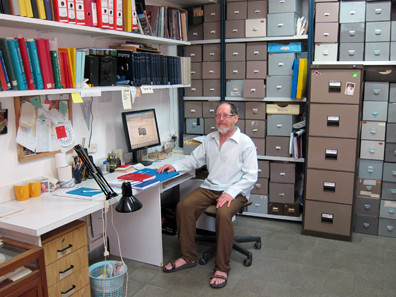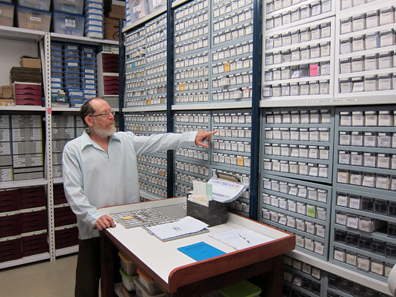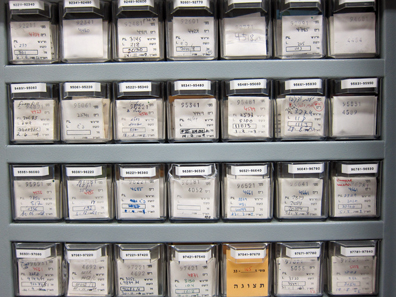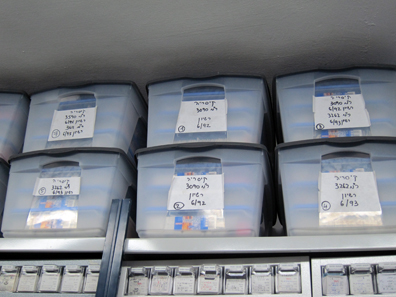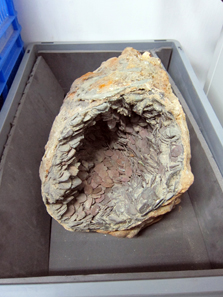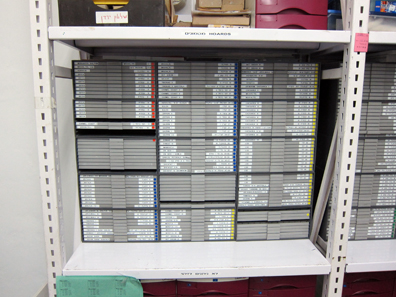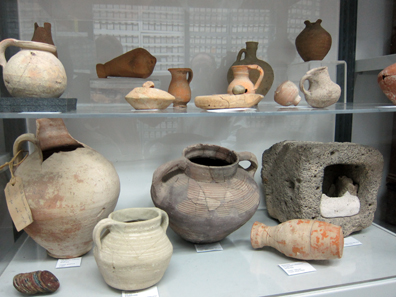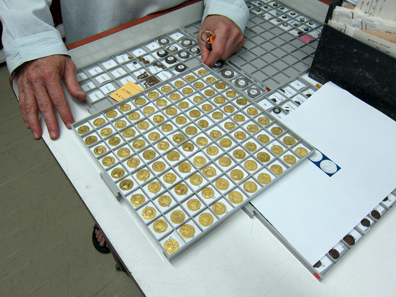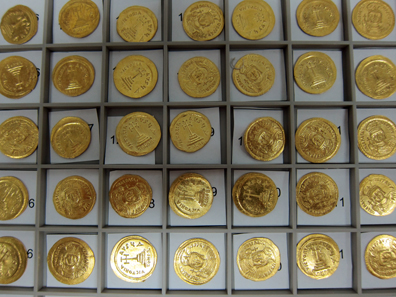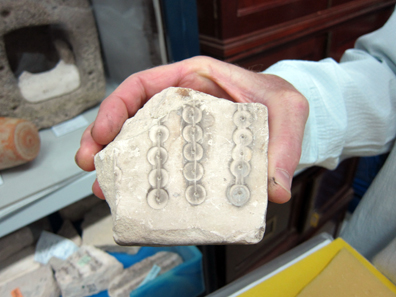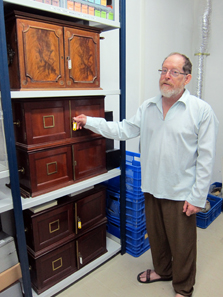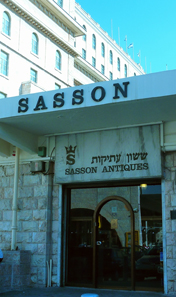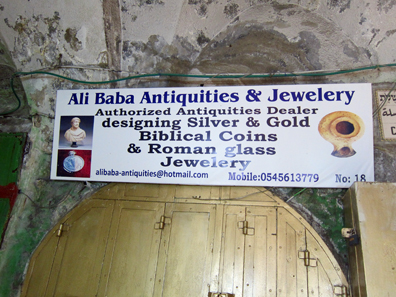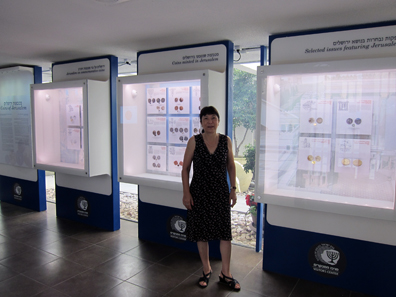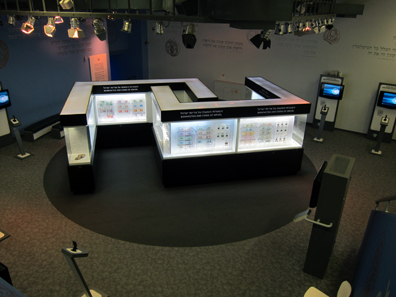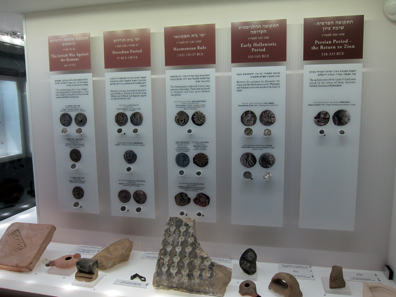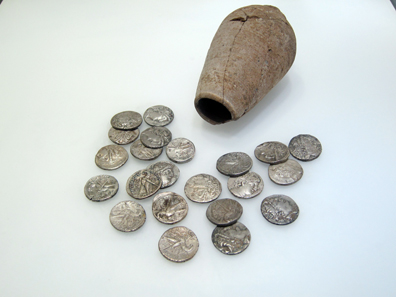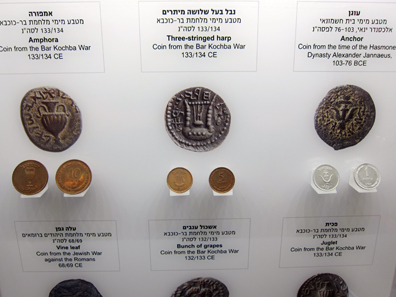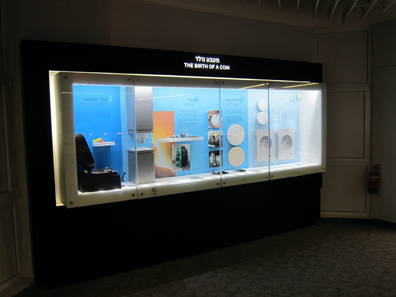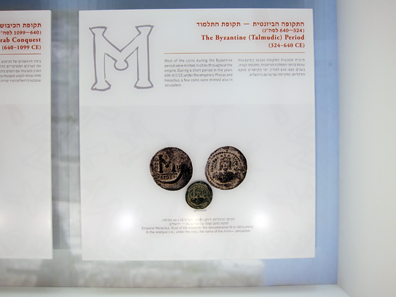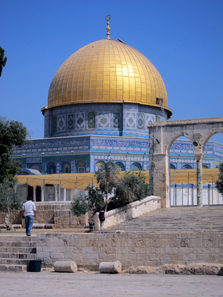by Ursula Kampmann
July 12, 2012 – To be honest, I would not have noticed that each one, the Bank of Israel and the Israel Antiquities Authority, possesses a coin collection of its own, if Haim Gitler had not told me so. Shame on me!, because these two places keep really important treasures. The Israel Antiquities Authority is specialized on excavated coins, while the exhibition of the Bank of Israel is a must-do to everybody who is interested in Israel’s modern coinage and banknotes.
Donald T. Ariel in his office. Photo: UK.
Let’s start with the Israel Antiquities Authority, since we are yet at the Israel Museum. Actually, the room where the work is done does not impress deeply. However, the work accomplished here may be labeled ‘spectacular’ without exaggeration.
We may cite on this behalf the recent publication of Donald Ariel dealing with the coins of Herod (40-4 BCE), comprising a die analysis, too. If you want to learn more about it, please click here.
The history of the Israel Antiquities Authority (IAA) dates back to 1924 when the British founded the British Mandate Antiquities ordinances. After the United Nations General Assembly had decided to realize the division of Palestine into an Arabic and a Jewish state, the British army withdrew on May 14, 1948. In the very night of the foundation of Israel the young state was declared war by Egypt, Saudi-Arabia, Jordan, Lebanon, Iraq and Syria. This war should continue until far into 1949.
One might think that in these troublesome months the Jewish government had a pile of things to do. However, history and particularly archaeology are of much bigger importance to Israel than to most other countries in the world. Because they touch the aspect of identity and the archaeological reasoning that Israel is the Promised Land of the Jews.
Still during the siege of Jerusalem the Israel Department of Antiquities was founded on July 26, 1948. Its task is to protect the country’s past by excavations and interpretation, but also acting as Cultural Heritage Protection.
Donald T. Ariel in the safe with excavated coins. Photo: UK.
In this safe some 800,000 coins are stored. Every year nearly 8,000 coins are added and identified, described and published. A total of three persons are concerned with the excavated coins.
The identified coins are deposited according to the order of their precise inventory numbers. Photo: UK.
Not only identification of the coins is part of their job but also storage and organizing the issue in case of requests on behalf of exhibitions. By the way, since two years all excavated coins are available for searching online.
Donald Ariel and his team are very proud of the fact that Jerusalem houses the largest coin collection with each coin having a verified pedigree. 142,000 pieces are catalogued one by one.
The unidentified coins are stored in large boxes. Photo: UK.
Some 300,000 out of the 800,000 coins could not be identified due to their state of preservation. They are stored in large boxes on top of the identified coins.
In all these years I have never seen such a small room containing so many coins so neatly stored away!
Hoard. Photo: UK.
The reason why Donald Ariel cannot tell how many coins exactly are stored in his little safe becomes obvious when looking at this photo. Some coin findings have not been disassembled but remained a single block. And now we have to estimate: How many coins might compose this mass?
Here the hoard findings are stored. Photo: UK.
By the way, each year about seven new hoards enter this room.
The coin department keeps all the vessels in which the coins were found. Photo: UK.
Here they store not only the coins but also the vessels in which the coins had been buried.
An important Byzantine coin hoard. Photo: UK.
Currently, they are particularly proud of a Byzantine coin hoard composed of 264 solidi of Heraclius shining proof-like.
All the coins belong to one type. Photo: UK.
Donald Ariel supposes that all these gold coins were struck right before the capture of Jerusalem by the Sassanids in 614. All coins were struck with official dies of the Constantinople mint maybe in Jerusalem to pay the Imperial army.
If you want to see other intriguing hoard findings, you may do so here.
There are other objects out of this really large collection available like coins under Persian rule, hellenistic coins and Roman coins.
All 50,000 objects of the National Treasures are shown here.
And there is a video clip of the Fatimid coin hoard, the so-called Ramla hoard.
Archaeological-numismatical object. Photo: UK.
Besides others you can find these plates which are very interesting as for the technical aspect since they were used to mold blanks.
The coin collection of the British Mandate Antiquities ordinances. Photo: UK.
Actually, not only excavated coins are stored here. The IAA stores currently the coin collection of the British Mandate Antiquities ordinances, too. The real properties have not been sorted out, yet. Maybe some day this coin collection has to be handed over to a Palestine state.
The Gideon Sasson Gallery is a IADAA member and specialized in antiquities trade exclusively with objects of an ascertained pedigree. Photo: Gideon Sasson.
The department of excavated coins takes also care of coin export licenses, because in Israel the antiquities trade is legal. Dealers, however, require a license to deal with ancient objects. Although there are nearly no purchasing and selling restrictions within the country, whenever something is to be shipped out of Israel the Israel Antiquities Authority decides whether considering it of national importance or not.
The interior of the Gideon Sasson Gallery. Photo: Gideon Sasson.
The subject is handled very pragmatically. Mass issues are not of interest, however, pieces of historical importance – like a year 5 shekel of the Jewish War – do not get any export license at all. This can result in a considerable financial loss to the proprietor of this coin as there exist more financially strong potential buyers abroad.
Shops dealing with ancient objects at the Jerusalem bazaar. Photo: UK.
When buying coins in Israel coin collectors should make sure that the dealer organizes the required formalities. Otherwise things may turn nasty during the departure.
Excavation at the foot of the Wailing Wall. Photo: UK.
The IAA, by the way, is a semi-private institution. This fact has a financial reason: An entrepreneur who constructs a building in Israel meets a high chance that in exactly this place ancient ruins will come up. For the following excavation the entrepreneur has to pay entirely before he will be permitted to execute his construction.
And at least in theory this holds true for someone who wishes to build a private residence, too. In order to avoid outsized charges a special fund was created to finance the excavations in places where private residences are to be built.
If you are interested in further information on the Israel Antiquities Authority, please click here.
Rachel Barkay is guiding us through the Bank of Israel Museum. Photo: UK.
But that shall be enough about archaeology. Let’s dedicate us to modern numismatics, hence to the coins of which the Bank of Israel is competent. The bank has established an excellent visitors’ center, which, however, one may see only by prior appointment. Those who wish to take a look at the Bank of Israel museum (naturally by prior appointment) should keep their passport at hand. The passport rests at the building’s entrance where the security check is performed, and instead you receive a visitor badge. And don’t be afraid, when returning this badge, you will get your pass port back (and don’t you dare to loose your badge!!!).
The major part of the exhibition is placed in two huge showcases. Photo: UK.
Rachel Barkay, curator of this wonderful exhibition guided us personally. Her commitment and enthusiasm put together with these extremely rare objects made time fly. The Bank of Israel possesses an extensive coin collection featuring some very particular rarities.
And by the way, the cases’ shape seen from above looks like the Hebraic abbreviation of the Israeli currency.
Ancient coins from Israel. Photo: UK.
After a short introduction to numismatics featuring the oldest coins the exhibition is dedicated primarily to Israel’s circulation coins.
Coin hoard with Seleucid tetradrachms. Photo: UK.
Naturally, very illustrative on this behalf is this small finding of Seleucid tetradrachms which came up in Maresha in 1989. This hoard influenced strongly on chronology since it is linked to the conquest of the city by Yehohanan Hyrcanus the first Hasmonean ruler. Thanks to the dating according to the Seleucid era we can determine exactly that this hoard was buried after 113/112 BCE. And this indicates that the city was captured some years earlier than previously thought.
A currency for Palestine. Photo: UK.
Those interested in banknotes will have their money’s worth out of a Bank of Israel visit. I personally enjoyed most of all the history of a banknote issue that has never come into circulation. In 1942, that means in the middle of World War II, the British Mandate administration became anxious about how to ensure the supply with banknotes since they were printed in London while the submarine war was pressing heavily on the allied forces.
Thus it was considered necessary to look for alternatives and High Commissioner Harold MacMichael planned to involve in printing the banknotes a Jerusalem based printer.
A letter from the High Commissioner to the printer. Photo: UK.
Pikovsky Zincography designed the banknotes and produced the plates. The notes were printed with the highest degree of secrecy and then, with only few exceptions, they were all destroyed since the London banknotes had reached the country just in time. However, the Bank of Israel keeps some original documents in its collection that testify of this thrilling story.
Virtually all coins in Israel have ancient models. Photo: UK.
In the showcases are exposed all banknote and coin issues since the foundation of Israel. In addition there are some very interesting tokens and necessity banknotes. It is really touching to see a small, greenish cardboard piece which served once to talmud pupils to get a loaf of bread during the siege of Jerusalem in 1947 / 1948.
Showcases on technique on the upper floor. Photo: UK.
On the upper floor there are two showcases featuring extremely interesting original material on the production of coins and banknotes. Photographs of various kibbuz girls picking fruits make clear that not one single woman served as model for the woman on the 1/2 lira banknote issued in 1959.
Here is also a room where the visitors may watch films produced by the Bank of Israel in order to explain what a central bank does.
Game computer stations. Photo: UK.
At the Bank of Israel they are particularly proud of how they teach the youth about the functions of the Bank of Israel. As a central bank, they have finally to counteract the inflation. On this behalf computer games are positioned along all the walls and may be played by using ‘book money’ stored on a credit card. The book money is free and the credit card may be recharged over and over again.
At the beginning one game costs 50 NIS, then the price is scaled up to 60 NIS. Photo: UK.
You might imagine what happens. All these youngsters want to play as often as possible. All the time the credit cards are recharged hastily. And since the money does not cost anything, the raising prices are of no problem to the players. The cards are charged again and again until suddenly on the display the director of the Bank of Israel appears and stops these goings-on. He states that there is no more free money, instead the base rate is raised substantially.
They are making very good experiences with that simple but nonetheless very impressive message. Maybe it could be a good idea to send a couple of EU finance ministers to the visitors’ center of the Bank of Israel …
A follis struck in Jerusalem. Photo: UK.
In front of the exhibition room there is a space reserved for special exhibitions. Currently there are coins exhibited that were struck in Jerusalem. Among them you can see this Byzantine follis on which is clearly written IEPOCO referring to Hierosolyma.
The Dome of the Rock. Photo: UK.
And now we must bid farewell to Jerusalem. Alas, we have to delay the visit of the Eretz Israel Museum in Tel Aviv with its wide-ranging collection on postal history, philately and numismatics.
Opening times and further details on the visitors’ center of the Bank of Israel are available here.
If you want to make an appointment with the visitors’ center of the Bank of Israel, please click here.
Here you can see more highlights of the collection of the Bank of Israel.
Are you looking for more information on the computer games? Here you are.
You can see here what we have missed in Tel Aviv of coins and of the philately.



